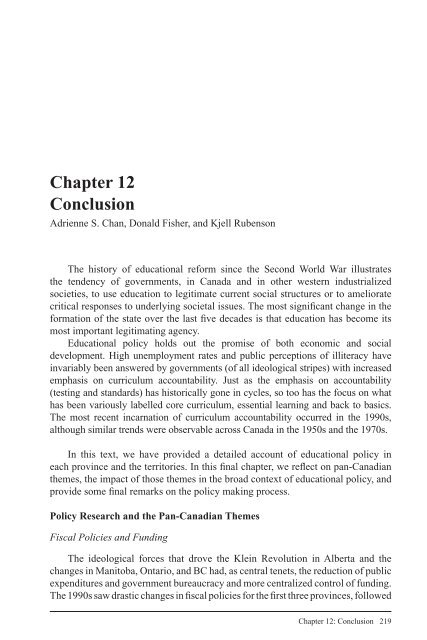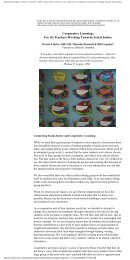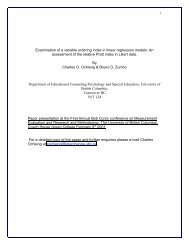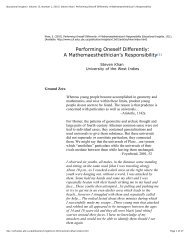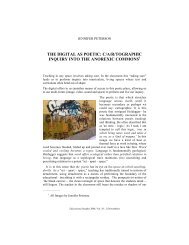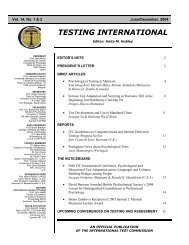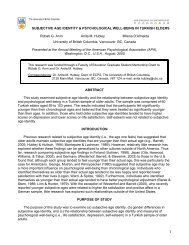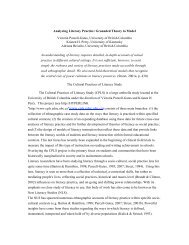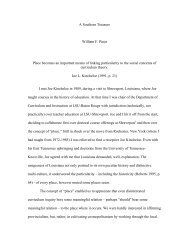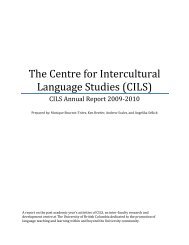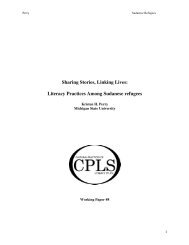- Page 3 and 4:
The evolution of professionalism: e
- Page 5 and 6:
Table of Contents Preface iii Intro
- Page 7 and 8:
iv Introduction
- Page 9 and 10:
The Context The history of teaching
- Page 11 and 12:
work to the different forms of capi
- Page 13 and 14:
describes May 1968 as a “historic
- Page 15 and 16:
simultaneously reacts to and create
- Page 17 and 18:
10 Introduction
- Page 19 and 20:
profession of teaching, standards,
- Page 21 and 22:
In 1991, the New Democratic Party w
- Page 23 and 24:
diversify their teaching skills and
- Page 25 and 26:
Policy required all students in Gra
- Page 27 and 28:
18, 2002, reported a current defi c
- Page 29 and 30:
Table 1. 1990-91 to 2002-03 Operati
- Page 31 and 32:
accompanied by acknowledged standar
- Page 33 and 34:
the number of teachers new to the B
- Page 35 and 36:
Lyon, D.R., and K.S. Douglas. 1999.
- Page 37 and 38:
30 Section 1: The West
- Page 39 and 40:
means of a resource manual. Three a
- Page 41 and 42:
schools followed a model already po
- Page 43 and 44:
and secure environments for all Alb
- Page 45 and 46:
from Kindergarten to Grade 3, 25 fr
- Page 47 and 48:
formed to assist the government wit
- Page 49 and 50:
• Develop and implement comprehen
- Page 51 and 52:
although principals and assistant p
- Page 53 and 54:
Alberta Learning. 2000. Shaping the
- Page 55 and 56:
48 Section 1: The West
- Page 57 and 58:
Saskatchewan’s educational polici
- Page 59 and 60:
As Tymchak (2001) has noted, this c
- Page 61 and 62:
The Government of Saskatchewan iden
- Page 63 and 64:
population (Saskatchewan Learning,
- Page 65 and 66:
As has been stated elsewhere in thi
- Page 67 and 68:
tests and Saskatchewan curriculum o
- Page 69 and 70:
) policy ideas begin as realization
- Page 71 and 72:
-- 2004a. Province responds to Boug
- Page 73 and 74:
In 1990, Filmon and his party were
- Page 75 and 76:
Outcomes-based Curricula The “New
- Page 77 and 78:
The last major alteration of school
- Page 79 and 80:
• The availability of qualifi ed
- Page 81 and 82:
of Manitoba Education and Youth (ww
- Page 83 and 84:
Levin, B. and J. Wiens. 2003. There
- Page 85 and 86:
78 Section 3: Central Canada
- Page 87 and 88:
Policy Trends 1960-1990 During a 30
- Page 89 and 90:
Within six months of the Royal Comm
- Page 91 and 92:
Bill 160 mandated greater restricti
- Page 93 and 94:
the specifi city in curriculum expe
- Page 95 and 96:
ecommended a funding increase of $1
- Page 97 and 98:
Secretariat, and committed $160 mil
- Page 99 and 100:
enable this to happen. This shift i
- Page 101 and 102:
from Liberals, to New Democrats, to
- Page 103 and 104:
-- 2003a. 97 percent of teacher can
- Page 105 and 106:
98 Section 3: Central Canada
- Page 107 and 108:
schools. Finally, the last section
- Page 109 and 110:
The Commission identifi ed 10 areas
- Page 111 and 112:
énoncé de politique et plan d’a
- Page 113 and 114:
• Twelve professional competencie
- Page 115 and 116:
tongue. In 2001, as part of the imp
- Page 117 and 118:
-- 1993. La décentralisation en é
- Page 119 and 120:
-- 1996. Rapport du groupe de trava
- Page 121 and 122:
Rulings Régime pédagogique de l
- Page 123 and 124:
personnel enseignant. La sixième p
- Page 125 and 126:
Troisième partie : le curriculum d
- Page 127 and 128:
Quatrième partie : La gouvernance
- Page 129 and 130:
À l’automne 1992, le ministre Pa
- Page 131 and 132:
• Un Comité sur les affaires rel
- Page 133 and 134:
l’imputabilité et de la redditio
- Page 135 and 136:
-- (1992), La gestion de l’éduca
- Page 137 and 138:
-- (1994), L’école au cœur des
- Page 139 and 140:
132 Section 3: Central Canada
- Page 141 and 142:
various players in the system, the
- Page 143 and 144:
The document noted that such a rest
- Page 145 and 146:
announced started in September 2003
- Page 147 and 148:
• creating a committee to establi
- Page 149 and 150:
each district as well. These commit
- Page 151 and 152:
Events Year Texts/policies/statemen
- Page 153 and 154:
-- 1993. Ministerial Statement - Sc
- Page 155 and 156:
Internet Sites Association des ense
- Page 157 and 158:
to be funded by a formula that comb
- Page 159 and 160:
Cameron’s wage freeze was followe
- Page 161 and 162:
standardized testing regime, much o
- Page 163 and 164:
Shore Boards) with a centralized um
- Page 165 and 166:
This fi nding effectively echoed te
- Page 167 and 168:
a tight-loose policy framework, cou
- Page 169 and 170:
Beginning in 1995, however, the “
- Page 171 and 172:
Conference Board of Canada. 1992. E
- Page 173 and 174:
-- 1998a. Program policy for French
- Page 175 and 176: 168 Section 4: The Atlantic Region
- Page 177 and 178: een falling. As of September 1995,
- Page 179 and 180: all actors in the Newfoundland and
- Page 181 and 182: school districts, MUN, and the NLTA
- Page 183 and 184: management trends in other Canadian
- Page 185 and 186: of schools”, especially given the
- Page 187 and 188: References Atlantic Provinces Educa
- Page 189 and 190: -- 1999. News Release (January 6):
- Page 191 and 192: -- 2004. Budget speech. St. John’
- Page 193 and 194: 186 Section 4: The Atlantic Region
- Page 195 and 196: In 1999, the Minister of Education
- Page 197 and 198: Grades 1 to 12 follow the program.
- Page 199 and 200: system results, the Department has
- Page 201 and 202: Other improvements included the int
- Page 203 and 204: participate in the early immersion
- Page 205 and 206: approximately 50 hours per week”
- Page 207 and 208: -- 2001d. Schools in Society. Charl
- Page 209 and 210: Lowther, L. 2004. Private written c
- Page 211 and 212: The Territories The Yukon Territory
- Page 213 and 214: to develop First Nations curriculum
- Page 215 and 216: Yukon Native Teacher Education Prog
- Page 217 and 218: profi t organizations are also impo
- Page 219 and 220: training, a new computer-based info
- Page 221 and 222: to Inuktitut, the language of the I
- Page 223 and 224: -- 2002. Standing Committee on Heal
- Page 225: -- 2003. Public Schools Branch Annu
- Page 229 and 230: change, although in the opposite di
- Page 231 and 232: and a core curriculum are intimatel
- Page 233 and 234: school must decide between an advis
- Page 235 and 236: thus policy was given as fait accom
- Page 237 and 238: combat racism. The French tradition
- Page 239 and 240: The discourse of inclusion is an at
- Page 241 and 242: of the Newfoundland and Labrador Te
- Page 243 and 244: (Brodie, 1995, p. 386). Similarly,
- Page 245 and 246: Table 9. School Councils Province N
- Page 247 and 248: References Alberta Learning. 2003.
- Page 249 and 250: 242 Appendices
- Page 251 and 252: 244 Appendices
- Page 253 and 254: Party: Premier Minister Ministry Po
- Page 255 and 256: Appendix 3. Saskatchewan Ministers
- Page 257 and 258: Appendix 4. Manitoba Ministers of E
- Page 259 and 260: Party: Premier Minister Ministry Po
- Page 261 and 262: Premier Political Party Lucien Bouc
- Page 263 and 264: Premiers ministres Partis Lucien Bo
- Page 265 and 266: Appendix 7. Premiers, Political Par
- Page 267 and 268: 260 Index
- Page 269 and 270: accountability, 38-39, 40, 222 curr
- Page 271 and 272: British Columbia, Ministry of Skill
- Page 273 and 274: curriculum for Aboriginal students,
- Page 275 and 276: Final Report of the Commission of C
- Page 277 and 278:
pan-Canadian themes, 231 population
- Page 279 and 280:
indicators of education, 144t langu
- Page 281 and 282:
governance structure changes in BC,
- Page 283 and 284:
languages, 230 per-student expendit
- Page 285 and 286:
einforcement of role, 136 religious
- Page 287 and 288:
Saskatchewan demographics, 55-57 Sa
- Page 289 and 290:
Y Year 2000: A Framework for Learni
- Page 291 and 292:
égalité des chances, 117, 121, 12


